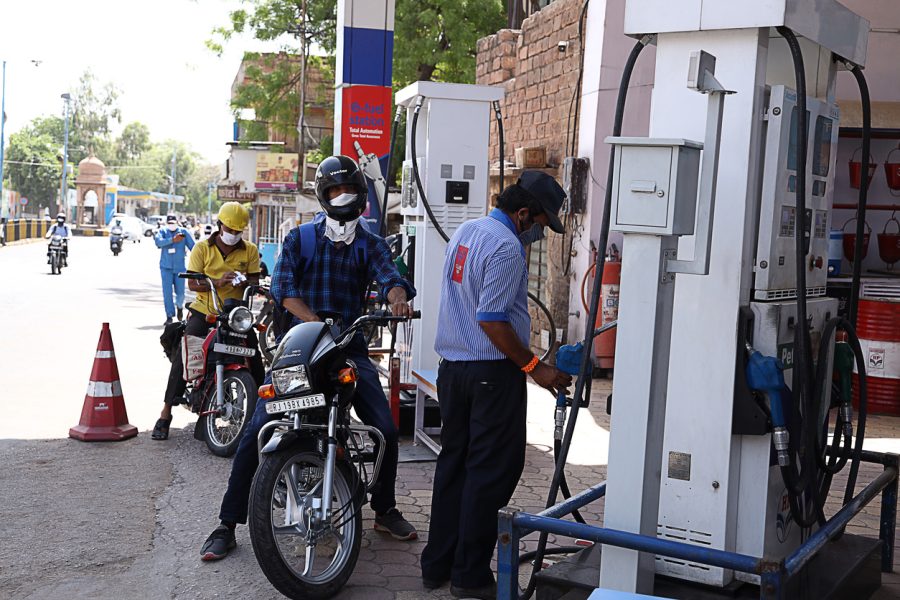
Centre-state tax row: Who gets what when you buy fuel for ₹100
Around 50% goes for the commodity per se, and the rest is tax; the fracas is over how the tax pie is divided

Over the past few months, fuel prices have been on fire, and sparks have been flying between the Centre and state governments over who is to blame for it. While the states accuse the Centre of high levies, the latter says states — particularly those ruled by opposition parties — are loath to pass on any tax cut it announces. At the heart of the issue is the declining fiscal autonomy of state governments.
Unlike other commodities, fossil fuel is out of the ambit of the Goods & Services Tax (GST) regime. This means each state has a different sales tax and Value-Added Tax (VAT) on petrol and diesel.
Also read: States demand more cuts on fuel tax, say slashing VAT will drain revenue
With the onset of GST, states have been complaining about thinning coffers, especially since the Centre has not been able to keep its promise of providing compensation for the loss of state revenues under the new tax regime. In this backdrop, the Centre’s call to states to trim VAT on fuel to tame inflation is hitting a raw nerve.
Where does the fuel money go?
The tax devolution in India is rather complex, with various components such as price of the commodity (which is mostly imported, and therefore subject to forex), state levies, Central tax, Central cess and dealer’s commission. Since each state has a different VAT structure, what you pay at the petrol station depends on where you are located.
Here, we take a fundamental, simplistic illustration. Assuming you pay ₹100 for a litre of petrol, ₹50-60 is accounted for by the base fuel price, dictated by international oil prices. This also includes freight charges. The balance ₹50-40 is made entirely of taxes, both Central and state. Around ₹23-26 goes towards the Centre’s excise duty; here, again, there are various components. Further, ₹3-4 is the dealer’s commission. The balance from the ₹50-40 goes to the states.
Also read: To offset fuel excise duty cut, Centre may borrow ₹1 lakh crore: Report
The ₹23-26 that goes to the Centre is further divided into four components. There’s a basic excise duty (forming less than 6 per cent of the Centre’s total fuel tax), a special excise duty, the Road and Infrastructure Cess (RIC), and an Agriculture and Infrastructure Development Cess (AIDC). Of the four, the Centre is obliged to share 42 per cent of what it collects as basic excise duty with the states. The rest fall under the cess and surcharge category — the Centre is not obliged to share these revenues with the states, and it doesn’t.
At the state level, the taxation gets more complex. Some states, such as Delhi, Odisha and Telangana, charge VAT at a fixed rate on the fuel; it goes up and down with the price of the fuel. Others, like Andhra Pradesh, Telangana and Tamil Nadu, have introduced a hybrid VAT system wherein there’s a VAT component on the fuel that varies from day to day, plus a flat charge per litre of fuel. Some other states have additional levies such as road development cess and pollution surcharge. Of the ₹100 you pay for one litre of fuel, around ₹15-20 goes to the state government.
Why are the states crying foul?
The states accuse the Union government of tweaking the fuel tax structure to build its own coffers. From 41 per cent in 2015, the portion of the Centre’s basic excise duty — the one shareable with the states — has fallen to less than 6 per cent. State revenues are hence compromised, say the respective governments.
Opposition-ruled states go up in arms whenever the Centre trims its tax on fuel and urges them to follow suit. This happened in November 2021, and again last week. “Many states, like Maharashtra, West Bengal, Telangana, Andhra Pradesh, Tamil Nadu, Kerala and Jharkhand (all Opposition-rule) did not agree to our request for some reason or the other, and the burden on the people of these states continued,” said Prime Minister Narendra Modi then, much to the chagrin of the respective state governments.
The states argue that it was the Centre that hiked the tax on fuel. So, when it chooses to trim the tax, it should not expect the states to follow suit. The fact that they have lost a lot of fiscal autonomy under the GST regime is making the states more belligerent. Fuel and alcohol taxation are the only key items under their quasi-control at present; the rest is under GST.
Absolute numbers
The Opposition-led state governments also point to the absolute numbers. The Centre’s tax revenues from petrol and diesel grew around 50 per cent between FY18 and Fy22, from ₹2.25 trillion to ₹3.35 trillion. The states’ own revenues, on the other hand, grew just 35 per cent over the same period, from ₹1.86 trillion to ₹2.52 trillion.
Also read: Burden of fuel tax cuts fully borne by Centre: Nirmala Sitharaman
When the Centre trimmed the tax on fuel last week, states raised a fuss, saying the portion of Central fuel tax revenue due to them would come down, too. However, Union Finance Minister Nirmala Sitharaman, in a series of tweets on Sunday, clarified that the trimming would happen from the RIC levy, which anyway is not being shared with states.


